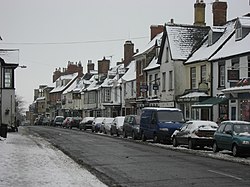Highworth
| Highworth | |
| Wiltshire | |
|---|---|
 The High Street, Highworth | |
| Location | |
| Grid reference: | SU2003592488 |
| Location: | 51°37’51"N, 1°42’43"W |
| Data | |
| Population: | 7,996 (2001) |
| Post town: | Swindon |
| Postcode: | SN6 |
| Dialling code: | 01793 |
| Local Government | |
| Council: | Swindon |
| Parliamentary constituency: |
North Swindon |
Highworth is a market town in Wiltshire, about six miles north-east of Swindon town centre. At the 2001 census it had a population of 7,996. It describes itself as the "gateway to the Cotswolds" but only on the recently erected signs, and is notable for its Queen Anne Style architecture and Georgian buildings dating from its pre-eminence in the 18th century.
The centre of the old town has been designated as a conservation area, with many fine Georgian and Queen Anne houses.
Highworth stands on a hill above the Upper Thames Valley, and at 436 feet above sea level it is reckoned the highest town in Wiltshire.[1]
Churches
The parish church is dedicated to St Michael and All Angels. The parish also has churches in Sevenhampton (St James') and Inglesham (St John the Baptist).[2]
The Highworth Community Church was founded over 30 years ago and is based in the Community Centre.[3]
Two Methodist chapels were built in 1838 and 1842, but the first one proved too small so a new one was built on The Elms in 1856. In 1964 the two groups came together to build a bigger chapel on the current site, which had to be enlarged further in 1992.[4]
History
Highworth stands on a hill which occupies a strategic position above the Upper Thames valley, and appears to have been occupied nearly continuously for 4000 years. It is listed in the Domesday Book as Wrde.[5] On John Speede's map of Wiltshire (1611), the name is spelt both Highwoth (for the hundred) and Hiworth (for the town itself). In 1206 it was granted a charter for its market, which is still held weekly.[6] The origins and layout of Highworth are mediæval.
Highworth was a royalist stronghold during the Civil War. It was captured for Parliament by Sir Thomas Fairfax on 17 June 1645 and garrisoned by Parliamentary troops until October the following year. Aside from the direct effects of war, the occupation coincided with a severe outbreak of plague. Traders moved their business to Swindon and Highworth market did not recover until the end of the 17th century. Highworth benefited from the economic boom during the Napoleonic Wars and Industrial Revolution, and many of the houses in the town centre date from this time.

People
Highworth was once larger than neighbouring Swindon, with a population of over 12,000.[7] The population in the 2001 census was 7,996.[8]
Economy
Many residents work at the Honda car factory between Highworth and Swindon. Highworth itself is a typical small market town with a variety of small shops; tourists use it as a base for the surrounding Cotswold Area of Outstanding Natural Beauty.
Sport
- Football: Highworth Town FC, who play at The Elms Recreation Ground.
Outside links
| ("Wikimedia Commons" has material about Highworth) |
References
- ↑ Highworth Historical Society website
- ↑ "Welcome - St Michael and All Angels". St Michael and All Angels, Highworth. http://www.stmichaelshighworth.co.uk/welcome.htm.
- ↑ "About Us". Highworth Community Church. http://highworth-swindon.org/about.
- ↑ "History". Highworth Methodist Church. http://www.highworthmethodistchurch.org.uk/history.html.
- ↑ Highworth previous names
- ↑ Highworth Market
- ↑ Highworth population info
- ↑ "Census 2001 Key Statistics - Urban areas in England and Wales KS01 Usual resident population". Office for National Statistics. http://www.ons.gov.uk/ons/rel/census/census-2001-key-statistics/urban-areas-in-england-and-wales/urban-areas-in-england-and-wales-ks01-usual-resident-population.xls.
